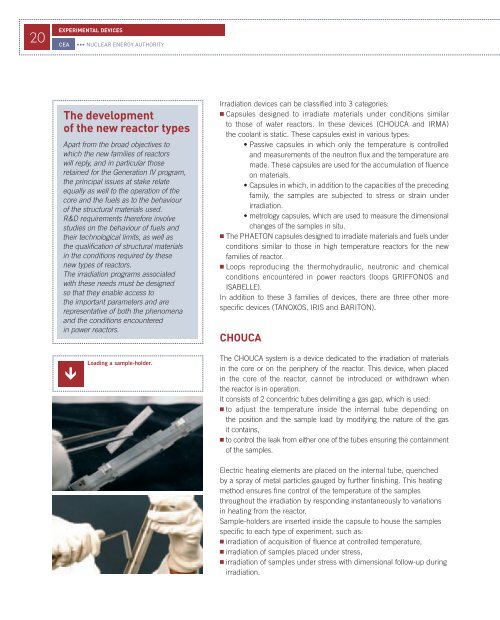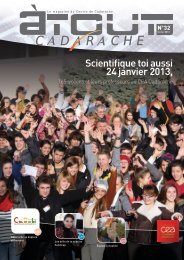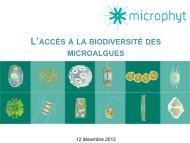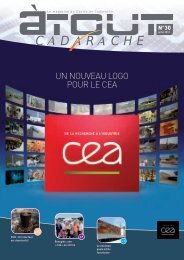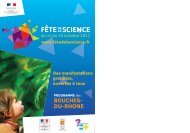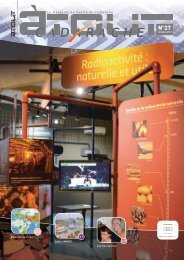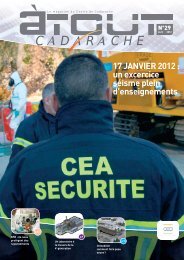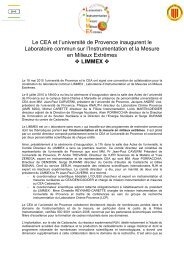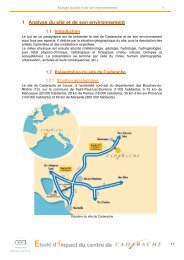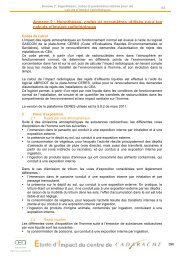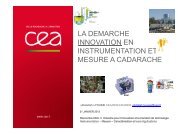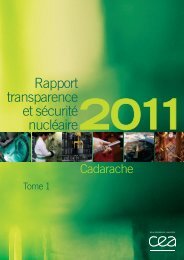OSIRIS REACTOR - Centre de Cadarache - CEA
OSIRIS REACTOR - Centre de Cadarache - CEA
OSIRIS REACTOR - Centre de Cadarache - CEA
- No tags were found...
Create successful ePaper yourself
Turn your PDF publications into a flip-book with our unique Google optimized e-Paper software.
20EXPERIMENTAL DEVICES<strong>CEA</strong>••• NUCLEAR ENERGY AUTHORITYThe <strong>de</strong>velopmentof the new reactor typesApart from the broad objectives towhich the new families of reactorswill reply, and in particular thoseretained for the Generation IV program,the principal issues at stake relateequally as well to the operation of thecore and the fuels as to the behaviourof the structural materials used.R&D requirements therefore involvestudies on the behaviour of fuels andtheir technological limits, as well asthe qualification of structural materialsin the conditions required by thesenew types of reactors.The irradiation programs associatedwith these needs must be <strong>de</strong>signedso that they enable access tothe important parameters and arerepresentative of both the phenomenaand the conditions encounteredin power reactors.Loading a sample-hol<strong>de</strong>r.Irradiation <strong>de</strong>vices can be classified into 3 categories: Capsules <strong>de</strong>signed to irradiate materials un<strong>de</strong>r conditions similarto those of water reactors. In these <strong>de</strong>vices (CHOUCA and IRMA)the coolant is static. These capsules exist in various types:• Passive capsules in which only the temperature is controlledand measurements of the neutron flux and the temperature arema<strong>de</strong>. These capsules are used for the accumulation of fluenceon materials.• Capsules in which, in addition to the capacities of the precedingfamily, the samples are subjected to stress or strain un<strong>de</strong>rirradiation.• metrology capsules, which are used to measure the dimensionalchanges of the samples in situ. The PHAETON capsules <strong>de</strong>signed to irradiate materials and fuels un<strong>de</strong>rconditions similar to those in high temperature reactors for the newfamilies of reactor. Loops reproducing the thermohydraulic, neutronic and chemicalconditions encountered in power reactors (loops GRIFFONOS andISABELLE).In addition to these 3 families of <strong>de</strong>vices, there are three other morespecific <strong>de</strong>vices (TANOXOS, IRIS and BARITON).CHOUCAThe CHOUCA system is a <strong>de</strong>vice <strong>de</strong>dicated to the irradiation of materialsin the core or on the periphery of the reactor. This <strong>de</strong>vice, when placedin the core of the reactor, cannot be introduced or withdrawn whenthe reactor is in operation.It consists of 2 concentric tubes <strong>de</strong>limiting a gas gap, which is used: to adjust the temperature insi<strong>de</strong> the internal tube <strong>de</strong>pending onthe position and the sample load by modifying the nature of the gasit contains, to control the leak from either one of the tubes ensuring the containmentof the samples.Electric heating elements are placed on the internal tube, quenchedby a spray of metal particles gauged by further finishing. This heatingmethod ensures fine control of the temperature of the samplesthroughout the irradiation by responding instantaneously to variationsin heating from the reactor.Sample-hol<strong>de</strong>rs are inserted insi<strong>de</strong> the capsule to house the samplesspecific to each type of experiment, such as: irradiation of acquisition of fluence at controlled temperature, irradiation of samples placed un<strong>de</strong>r stress, irradiation of samples un<strong>de</strong>r stress with dimensional follow-up duringirradiation.


